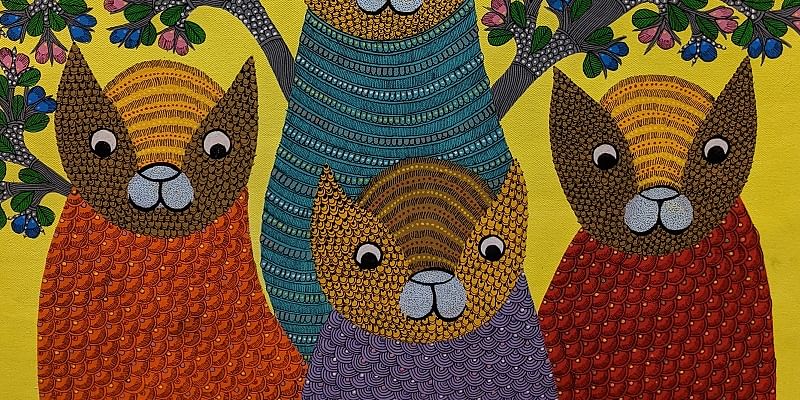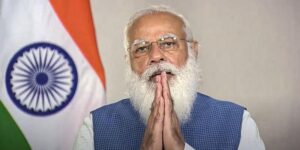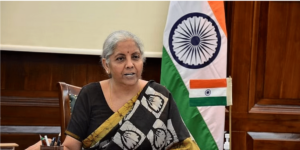Launched in 2014, PhotoSparks is a weekly feature from YourStory, with photographs that celebrate the spirit of creativity and innovation. In the earlier 630 posts, we featured an art festival, cartoon gallery. world music festival, telecom expo, millets fair, climate change expo, wildlife conference, startup festival, Diwali rangoli, and jazz festival.
Karnataka Chitakala Parishath recently hosted an outstanding exhibition and workshop series, titled Endangered Folk Arts of India. See Part I and Part II of our photo essay, and coverage of the earlier exhibitions Chitra Santhe, Moghi’s Tales, Team Yuva Collective, Aadipaaya, and Print India Biennale.
The event was organised by the International Indian Folk Art Gallery (IIFAG), an Australian art organisation with deep Indian roots. There were also eight workshops on folk art forms such as pichwai, madhubani, gond, phad, warli, pattachitra, kangra, and bhil.
The workshop leaders were Daulat Ram, Avadhesh Kumar Karn, Raman Singh Vyam, Abhishek Joshi, Anita Dalavi, Sushant Maharana, Vandana Rajah, and Shanta Bhuriya.
The exhibition journey
“My vision was to showcase as many folk arts of India as possible under one roof, providing an opportunity to art lovers to experience the true depth of Indian art and culture that is fast disappearing,” explains Senthil Vel, Founder of IIFAG, in a chat with YourStory.
The exhibition shows the similarity in folk tales as well as differences in styles and beliefs. “The feedback from visitors on this amazing experience was truly fulfilling. I wish we had more gallery space and more artforms,” he adds.
IIFAG aims to support underprivileged Indian folk artists by promoting and selling their artwork for sustainable living. It also enables knowledge transfer to the next generation through exhibitions and workshops.
There was a kickoff event in Mumbai earlier this year, followed by two events in Australia. Future events are lined up in Melbourne and Washington, Senthil says.
Purpose and impact
“I consider myself to be a privileged artist without having to worry about what will be on the dinner table tonight. But sadly, this is the biggest concern for most of the traditional Indian artists who are struggling to make ends meet,” Senthil laments.
Many folk artists have left the creative space and sought other jobs. “Such is the pathetic state of our artists. It is our responsibility to ensure that their art can continue to be enjoyed for generations to come,” he affirms.
“Success for us would be when every artist who has left this industry returns to continue the tradition, when every child feels that this profession is as good or better than others, and when every art buyer buys our traditional folk art with pride without haggling for the price,” Senthil evocatively describes.
Art appreciation
“Increasing art appreciation in society calls for finding new ways to engage with audiences,” explains Dushyant Dangi, Founder of Tribal Art India, who participated in the exhibition.
“In the modern internet society, attention spans have been reduced to a minimum. Even videos are reduced to between three and ten seconds,” Dusyant observes.
“The internet can be an effective tool to reach more people, and educate them about the history and culture associated with art,” he explains.
From the artistic side, it is important for the community to work on the uniqueness of their art. “We need to keep innovating via experiments. We also need to organise the history of art and what the motifs in paintings mean, so the next generation can understand and learn about it,” Dushyant advises.
In that regard, digit art, and NFTs (Non-Fungible Tokens) can open up new markets. “I think objects and motifs of tribal paintings can also be used in the gaming industry as skins and styles,” he suggests.
Senthil observes that there is a lot of attention paid to Western styles of art, but Indian folk art has been neglected over centuries of colonial rule. “A huge amount of investment needs to be done by both government and private organisations to bring about more recognition for Indian folk art,” he suggests.
Pandemic and beyond
“The pandemic made the situation worse and accelerated the fading of Indian folk arts. It widened the gap between buyers and sellers. Artists who could not reach buyers outside of their small shops simply left the industry,” Senthil recalls.
“There is also a lot of low-quality junk made by DIY artists learning from free YouTube videos. This has caused a lot of confusion in the market,” he adds.
IIFAG plans to continue to work on its core strategy of promoting Indian folk art online and through events. “We will continue to find highly experienced and skilled teachers who can help pass on their knowledge to the next generation,” Senthil emphasises.
The digital platform Tribal Art India was actually started amid the pandemic. “We had a great response during the whole period of COVID-19. For artists, it was a very tough period as there were no physical exhibitions and most of them usually depends on the offline market,” Dushyant says.
“Our next step is to get more tribal and folk artists to join us. Currently we are limited to gond, bhil and dokra art,” he explains.
Other steps include starting a workshop area where artists can meet, collaborate and innovate in areas like digital art.
Messages and impact
Dushyant also offers words of advice for aspiring artists. “Keep learning and evolving. Adding uniqueness in your work is the key. And don’t underestimate the power of the internet,” he suggests.
“Nothing in the world comes easy. No success comes in a day. Whenever you see a success story that supposedly happened in a day, there are actually years of hard work behind it. Keep improving,” Dushyant advises.
“Learning from the proper guru is very important. Understand the stories behind each artwork and share the stories with your art lovers,” Senthil suggests.
“This will create better engagement and appreciation of our art and the rich culture it represents,” he adds. The media also play an important role in spreading awareness to revive the endangered folk arts of India.
“There is no art or artists without buyers or art lovers. I can only urge art lovers to open up and discover the amazing world of Indian folk arts,” Senthil signs off.
Now, what have you done today to pause in your busy schedule and find new avenues to apply your creativity?
(All exhibition photographs were taken by Madanmohan Rao on location at the exhibition.)
See also the YourStory pocketbook ‘Proverbs and Quotes for Entrepreneurs: A World of Inspiration for Startups,’ accessible as apps for Apple and Android devices.










